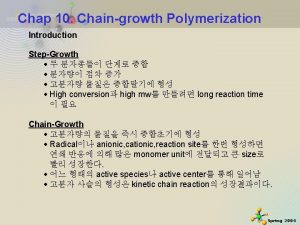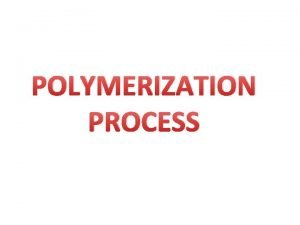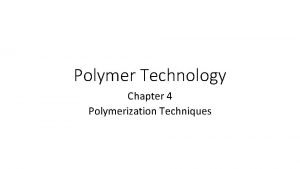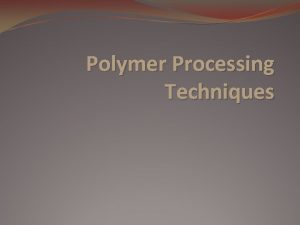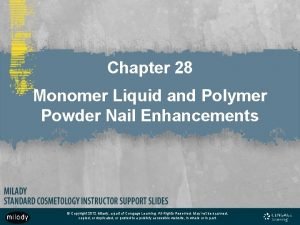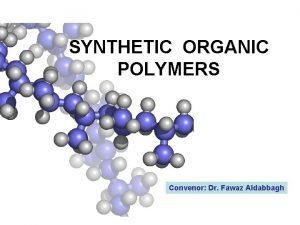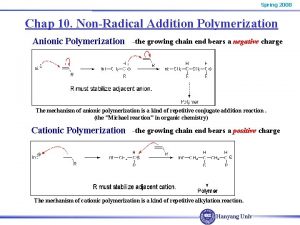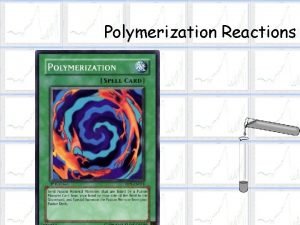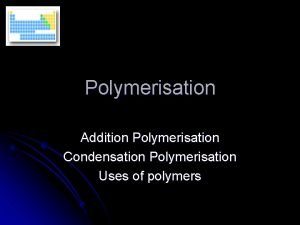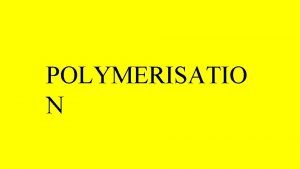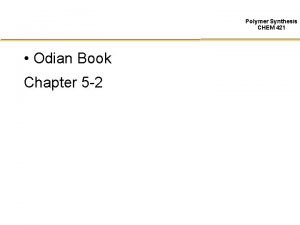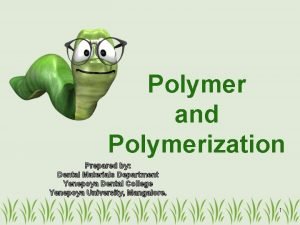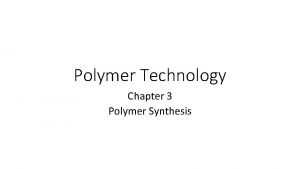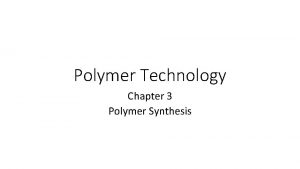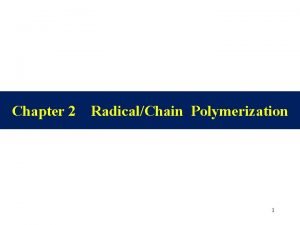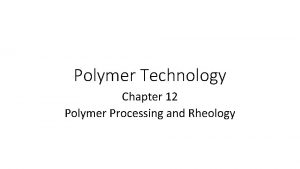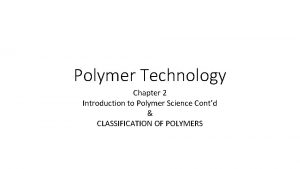Polymer Technology Chapter 4 Polymerization Techniques Polymerization Techniques












- Slides: 12

Polymer Technology Chapter 4 Polymerization Techniques

Polymerization Techniques • Ionic polymerization, which can be anionic or cationic types, follows the same basic steps as free-radical chain-growth polymerizations, which are the initiation step, the propagation step and the termination step). • But there are some important differences between the ioni polymerization and the free-radical chain-growth polymerization reaction. • Either a carbanion (C-) or carbonium (C+) ionic site can be formed instead of the free radical in the initiation step of the ionic polymerization reaction. • As commercial examples, the polymerization reactions of vinyl monomers with an electron-withdrawing group can proceed by an anionic pathway, while monomers with an electron-donating group such as methyl can polymerize by a cationic mechanism.

Polymerization Techniques • The active molecule necessary for the initiation step of the ionic polymerization ‘initiator’ should be any strong nucleophile which includes Grignard reagents (RMg. X) and other organometallic compounds like n-butyl (n-C 4 H 9) lithium. • As an example for the anionic type of ionic polymerization, the anionic initiation of styrene can be illustrated below: • During the initiation step of the anionic type of ionic polymerization, the addition of the butyl anion to styrene results a carbanion at the head end in association with the positively charged lithium counterion. • The resulting chain propagates by insertion of additional styrene monomers between the carbanion and counterion.

Polymerization Techniques • If the starting reagents for the anionic type of ionic polymerization are pure and if the polymerization reactor at which the reacions take place is purged of all oxygen and traces of water, the propagation can proceed indefinitely or until all monomer is reacted or consumed. • Therefore, the anionic type of the ionic polymerization reaction is sometimes called living polymerization reaction. • In this case, the termination step of the anionic type of the ionic polymerization reaction occurs only by the deliberate introduction of oxygen, carbon dioxide, methanol, or water as follows:

Polymerization Techniques • Unlike the free-radical polymerization and the anionic type of the ionic polymerization reactions, the initiation in the cationic type of the ionic polymerization employs a catalyst, which is restored at the end of the polymerization and does not become incorporated into the terminated polymer chain. • Any strong Lewis acid like boron trifluoride (BF 3) can be used as the catalyst for the cationic type of the ionic polymerization. • At this case, a co-catalyst such as water molecule is required as the actual proton source. • The initiation step with the cationic polymerization reaction can be shown for the commercially important example of isobutylene polymerization below:

Polymerization Techniques • As stated before, proton addition yields a t-butyl carbonium ion, forming an association with the BF 3 • OH counterion or gegen ion. • The carbonium ion can be added to the double bond of another isobutylene molecule during propagation step of the cationic type of the ionic polymerization, as following: • Different form the case observed with the free-radical polymerization, the termination step by combination of two cationic polymer chains cannot occur with the cationic type of the ionic polymerization reactions. • In certain type of the cationic polymerization reactions, a distinct termination step may not take place; but a chain transfer to a monomer, polymer, solvent, or counterion will usually occur.

Polymerization Techniques • The process of chain transfer to the counterion is illustrated as followins on the given reaction: • As this termination step of the cationic type of the ionic polymerization exhibits, the catalyst and the co-catalyst are restored at the end of the cationic polymerization.

Polymerization Techniques • The simplest polymerization method, which reasult the highest-purity polymer, is the bulk polymerization method. • At this polymerization technique, only monomer, a monomer-soluble initiator, and a chain-transfer agent to control molecular weight are added into the reaction medium. • Advantages of this polymerization method include high yield per reactor volume, easy polymer recovery, and the option of casting the polymerization mixture into final product form.

Polymerization Techniques • Disadvantages of this polymerization method are the difficulty of removing residual traces of monomer and the problem of the removal of heat produced during the polymerization reaction. • The free-radical polymerization reactions are highly exothermic, ranging from 42 to 88 k. J/mol). • In contrast to the high reaction heat, thermal conductivity of organic molecules like monomers and polymers is low compared to the inorganic materials. • An increase in the reaction temperature will increase the reacion rate of the polymerization reaction and, therefore, it generates additional heat to remove. • The heat dissipation becomes particularly difficult near the end of the polymerization reaction when the viscosity the reaction medium is high. • High viscosity hinders the diffusion of long-chain radicals needed for termination.

Polymerization Techniques • When the viscosity of the reaction medium increases, mixing and heat transfer become difficult as expected. • High viscosity of the reaction medium results to the problems with the removal of volatile byproducts and to the change in the kinetics of the polymerization reaction from a chemical-controlled regime to a diffusion-controlled regime. • The heat removal problem leads to the development of localized hot spots or runaway reactions. • Uncontrolled runaway reactions or hot spots may be ultimately disastrous for the resulting polymer. • The local hot spots can result in the discoloration or degradation of the resulting product. • As a precaution, the heat removal can be enhanced by providing special baffles for enhanced heat transfer or by conducting the bulk polymerization in separate steps of low to moderate conversion.

Polymerization Techniques • The bulk-polymerization technique can be used for many free-radical polymerizations and step-growth polymerization reactions. • The bulk polymerization techniqeu is ideally suited for making pure polymeric products, such as optical grade poly(methyl methacrylate) or impact-resistant polystyrene since this technique provides minimal contamination of the product. • But the removal of the unreacted monomer is usually necessary, and it is not easy with the bulk polymerization technique. • It can be achieved in vacuum extruders at which the molten polymer is extruded under vacuum to remove the residual monomer. • Commercial examples of polymers polymerized by free-radical bulk polymerization are polystyrene and poly(methyl methacrylate). • Low-density polyethylene and certain ethylene copolymers can also be produced by bulk free-radical polymerization reactions.

References • Robert O. Ebewele, «POLYMER SCIENCE AND TECHNOLOGY» , CRC Press, 2000. • Fried, Joel R. , «Polymer science and technology» , Prentice Hall, Third edition.
 Step polymerization vs. chain polymerization
Step polymerization vs. chain polymerization Solution polymerization
Solution polymerization Polymerization techniques
Polymerization techniques Plastic processing techniques
Plastic processing techniques What are the definitions of apex stress area and sidewall
What are the definitions of apex stress area and sidewall Polymerization of monomers
Polymerization of monomers Anionic polymerization mechanism
Anionic polymerization mechanism Bulk polymerization definition
Bulk polymerization definition What is polymerization
What is polymerization Condensation polymerisation
Condensation polymerisation Types of polymerization
Types of polymerization Cationic polymerization
Cationic polymerization Polymerization in dentistry
Polymerization in dentistry
